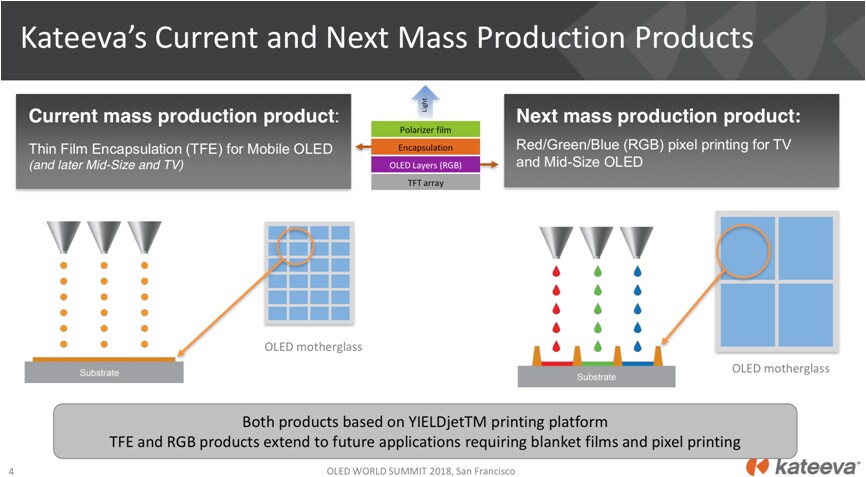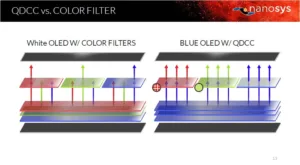Suppliers, customers and industry watchers gathered at OLEDs World Summit 2018 in San Francisco on Sept 18-20 to discuss industry trends. OLED display has established its strong presence in smartwatches, AR/VR as well as in the premium smartphone and TV markets.

Suppliers are striving to bring in new materials, manufacturing process, solutions and production capacities to reduce cost and expand market. OLED technology is poised for next generation product innovations while still resolving current issues and challenges.
Flexible OLED: Strong presence in smartphone
Apple’s iPhone X and Samsung Galaxy smartphones are helping flexible OLED volume growth. The seasonal nature of the market and slower than expected sales have resulted in lower utilization rates and some delays in developing new capacity to make flexible OLEDs. Higher prices are limiting unit sales of finished devices. Rigid OLED smartphones can be more price-competitive with LTPS LCD, but rigid OLED capacity is low since most of China’s upcoming capacity is in flexible OLED. New and higher capacity in 2019 and beyond could bring price reductions in future, leading to higher growth and higher market share for flexible OLED. More smartphone brands are adopting OLED for their products. According to the DSCC presentation at the OLEDs Summit, OLEDs will overtake LCDs in the smartphone display market in 2022.
Foldable display coming: Many challenges
OLED Panel suppliers are developing foldable display to enable design differentiation. Foldable smartphones require replacement of glass by plastic for the substrate film as well as the cover window film. Foldable displays bring many new challenges especially from the stress management prospective. Film stacks need to be engineered to lower stress. Film has to withstand repeated mechanical movements. For the thin film encapsulation (TFE) stack this could mean new materials and thinner layers. Other challenges include process technology, materials, manufacturing issues, higher costs, durability of the products and many others.
Samsung Display is in the forefront, providing foldable smartphone displays to Samsung Electronics and to other top smartphone brands. BOE may join the market in 2019 to produce foldable display. Industry analysts expect the first foldable smartphone to be launched in 2018, but only in very limited quantities. More products are expected in 2019. DSCC is forecasting demand for foldable units to be 6.1 million in 2019 rising to 67 million units in 2022. Most of the foldable products will be smartphones but foldable tablets and notebooks are also expected in the future.
OLED TV: Growing presence in premium market
OLED has secured a strong presence in the premium TV market because of picture quality and design differentiation. The self-emissive pixel dimming of OLED enables perfect black and an infinite contrast ratio providing great picture quality. LG Display’s OLED TV panel is based on white OLED on an Oxide TFT substrate. LG Electronics is the most successful brand with LG Display’s OLED TV panels. But now other brands such as Sony, Panasonic, Skyworth, TPV, Hisense, Konka and others have joined in, using LG Display’s panel. LGD is converting LCD TV capacity to OLED TV and may be accelerating its plans to develop 10.5G capacity. DSCC is forecasting OLED TV shipments to increase from 1.89 million units in 2017 to 3 million units in 2018 to 14.6 million units in 2022, including QDOLED TV from 2021.
QDOLED: A new solution for the TV market
A Quantum Dot OLED solution for TV is starting to emerge. Samsung Display showcased a 18-inch QDOLED at CES. The company seems to be accelerating research into QDOLED panel production for TV and may start operation of a 8.5G pilot line in 2019. According to a Nanosys presentation, a quantum dot color convertor (QDCC) has a number of advantages for OLED. It is much more efficient to replace the color filter in white OLED for TV with QDCC for greater luminance and increased color gamut. It also simplifies the panel structure and fabrication process and eliminates shadow mask patterning (which Samsung uses for small OLEDs, but could not scale for large OLEDs Man. Ed.).
However, the process needs long life and highly efficient blue OLED materials. There is also a need to improve cadmium free quantum dot performance to increase blue light absorption as QDCC performance is partially limited by it. QDCC promises improved efficiency, high color gamut, lower cost integration, better color, and elimination of shadow mask pattering for QDOLED TV display.
Image 2 – QDCC Colour Filter. Source:Nanosys
AR/VR: Shift to ultra high resolutions
OLED microdisplay has enabled the VR market by providing a compact form factor, an immersive experience, lower cost and better viewing performance. VR and MR application require high resolutions, large field of view, no screen door effect, fast speed, high contrast, high brightness, and realistic color. AR requires high brightness (>2000 cd/m²) and high contrast displays for see-through applications. Full color OLED microdisplays have high contrast but need higher brightness for AR applications. eMagin has introduced a full color direct patterned AMOLED microdisplay with 2K x 2K pixel format, 2730 PPI and more than 5000 cd/m² peak brightness. It has also demonstrated a device with more than 7500 cd/m² in full color.
OLED Materials: Need for more efficient blue emitter
The OLED industry is still searching for higher efficiency and longer lifetime materials. R and D in OLED materials and equipment are progressing. Universal Display Corp (UDC) has been commercially producing phosphorescent OLED materials successfully for many years. PHOLED materials have enabled good power efficiency; increased lifetime and performance improvements in OLED. The industry is still facing challenges due to inefficient blue emitters. OLEDs use red, green and blue emitters. There is a race to provide the most efficient dark blue with long lifetime, which can reduce power consumption and increase lifetime. While the industry is working on better blue phosphorescence, Kyulux is working on a Hyperfluorescence solution while Cynora is working on TADF for emitter technology.
Inkjet printing: New manufacturing process
Kateeva is currently mass-producing inkjet equipment for thin film encapsulation (TFE) for mobile OLEDs and is planning TFE for mid-size and TVs in the future. The company is aiming to mass produce RGB pixel printing for TV and mid-size OLED. Existing mobile technology uses patterned pixels created with a shadow mask evaporation process. However, this process has been unable to scale up to TV with low cost or good yield. White OLED with RGB color filter is currently in production by LGD, but the cost is still high.
Inkjet RGB pixel printing could enable higher brightness and lower cost OLED TVs with efficient use of RGB materials, no color filter or shadow mask and scalable to large size glass. Ink jet printing (IJP) can offer lower manufacturing cost due to lower capex, lower material cost from, simple structure and color filter elimination. But the lifetime of soluble blue OLED needs improvement. Many technological advances in ink jet printing were made to overcome the barriers to mass production.
 Kateeva presented this slide at the OLED Summit. Re-used with permission.
Kateeva presented this slide at the OLED Summit. Re-used with permission.
JOLED has shown a 21.6-inch printed OLED panel with 3840 x 2160 resolution for the monitor market. JOLED is building a gen 5.5 line for printed OLEDs.
OLED display is taking market share away from LCD and is increasing its presence in the smartphone, TV, AR/VR , smartwatch markets. It is also opening up new opportunities in automotive, tablet, notebook and many other applications. LCD is reinventing itself and new solutions such as QD backlight LCD, miniLED backlight LCD and others are coming to market. New competitive display technologies such as microLED, and QD emissive are expected to come in the future. OLED suppliers are bringing in new materials, new processes, new solutions and new capacities in 2019 and beyond to drive growth and get ready for next generation product innovations. Sweta Dash
Sweta Dash is the founding president of Dash-Insights, a market research and consulting company specializing in the display industry. For more information, contact [email protected] or visit www.dash-insight.com

